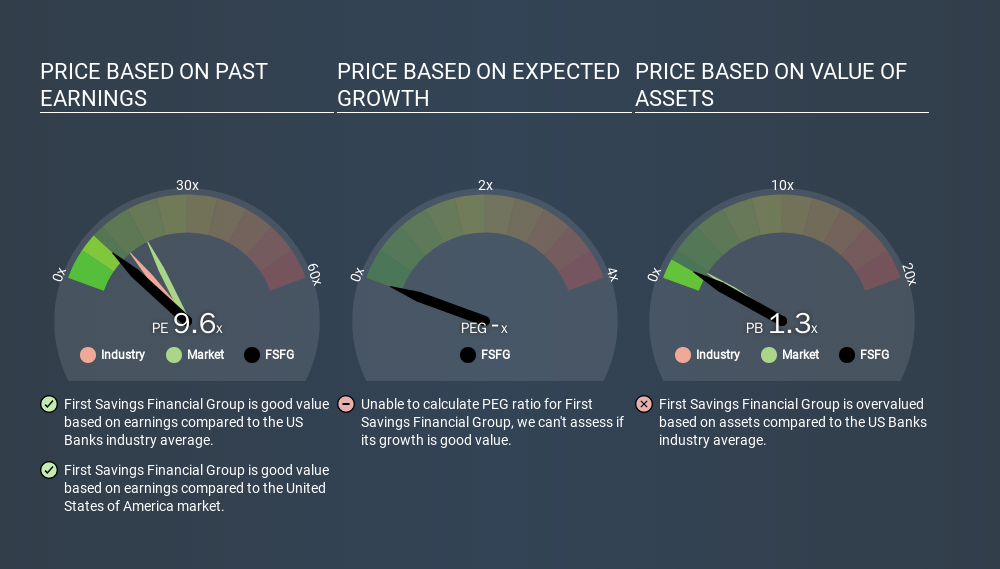- United States
- /
- Banks
- /
- NasdaqCM:FSFG
Read This Before You Buy First Savings Financial Group, Inc. (NASDAQ:FSFG) Because Of Its P/E Ratio
Of late the First Savings Financial Group (NASDAQ:FSFG) share price has softened like an ice cream in the sun, melting a full . But there's still good reason for shareholders to be content; the stock has gained 12% in the last 90 days. Looking back over the last year, the stock has been a solid performer, with a gain of 30%.
Assuming no other changes, a sharply higher share price makes a stock less attractive to potential buyers. In the long term, share prices tend to follow earnings per share, but in the short term prices bounce around in response to short term factors (which are not always obvious). So some would prefer to hold off buying when there is a lot of optimism towards a stock. One way to gauge market expectations of a stock is to look at its Price to Earnings Ratio (PE Ratio). A high P/E implies that investors have high expectations of what a company can achieve compared to a company with a low P/E ratio.
Check out our latest analysis for First Savings Financial Group
How Does First Savings Financial Group's P/E Ratio Compare To Its Peers?
We can tell from its P/E ratio of 9.65 that sentiment around First Savings Financial Group isn't particularly high. We can see in the image below that the average P/E (12.9) for companies in the banks industry is higher than First Savings Financial Group's P/E.

Its relatively low P/E ratio indicates that First Savings Financial Group shareholders think it will struggle to do as well as other companies in its industry classification. Since the market seems unimpressed with First Savings Financial Group, it's quite possible it could surprise on the upside. You should delve deeper. I like to check if company insiders have been buying or selling.
How Growth Rates Impact P/E Ratios
Generally speaking the rate of earnings growth has a profound impact on a company's P/E multiple. That's because companies that grow earnings per share quickly will rapidly increase the 'E' in the equation. And in that case, the P/E ratio itself will drop rather quickly. So while a stock may look expensive based on past earnings, it could be cheap based on future earnings.
It's nice to see that First Savings Financial Group grew EPS by a stonking 45% in the last year. And it has bolstered its earnings per share by 23% per year over the last five years. With that performance, I would expect it to have an above average P/E ratio.
Remember: P/E Ratios Don't Consider The Balance Sheet
It's important to note that the P/E ratio considers the market capitalization, not the enterprise value. Thus, the metric does not reflect cash or debt held by the company. The exact same company would hypothetically deserve a higher P/E ratio if it had a strong balance sheet, than if it had a weak one with lots of debt, because a cashed up company can spend on growth.
Spending on growth might be good or bad a few years later, but the point is that the P/E ratio does not account for the option (or lack thereof).
How Does First Savings Financial Group's Debt Impact Its P/E Ratio?
First Savings Financial Group has net debt worth a very significant 115% of its market capitalization. This level of debt justifies a relatively low P/E, so remain cognizant of the debt, if you're comparing it to other stocks.
The Verdict On First Savings Financial Group's P/E Ratio
First Savings Financial Group trades on a P/E ratio of 9.6, which is below the US market average of 18.6. The company has a meaningful amount of debt on the balance sheet, but that should not eclipse the solid earnings growth. If the company can continue to grow earnings, then the current P/E may be unjustifiably low. Given First Savings Financial Group's P/E ratio has declined from 9.6 to 9.6 in the last month, we know for sure that the market is more worried about the business today, than it was back then. For those who prefer invest in growth, this stock apparently offers limited promise, but the deep value investors may find the pessimism around this stock enticing.
Investors should be looking to buy stocks that the market is wrong about. If it is underestimating a company, investors can make money by buying and holding the shares until the market corrects itself. So this free report on the analyst consensus forecasts could help you make a master move on this stock.
Of course, you might find a fantastic investment by looking at a few good candidates. So take a peek at this free list of companies with modest (or no) debt, trading on a P/E below 20.
If you spot an error that warrants correction, please contact the editor at editorial-team@simplywallst.com. This article by Simply Wall St is general in nature. It does not constitute a recommendation to buy or sell any stock, and does not take account of your objectives, or your financial situation. Simply Wall St has no position in the stocks mentioned.
We aim to bring you long-term focused research analysis driven by fundamental data. Note that our analysis may not factor in the latest price-sensitive company announcements or qualitative material. Thank you for reading.
About NasdaqCM:FSFG
First Savings Financial Group
Operates as the bank holding company for First Savings Bank that provides various financial services to consumers and businesses in southern Indiana.
Flawless balance sheet with proven track record and pays a dividend.
Similar Companies
Market Insights
Community Narratives



